Brand Management Report: Strategies for KFC and McDonald's Success
VerifiedAdded on 2020/07/23
|13
|3968
|32
Report
AI Summary
This report provides a comprehensive analysis of brand management principles, using KFC and McDonald's as case studies. It begins with an introduction to branding as a marketing tool, exploring its emergence in business practices and the key components of brand strategy. The report delves into the importance of brand equity, differentiating it from product characteristics, and examines crucial elements for building a strong brand, including target audience, brand promise, perception, value, voice, and positioning. Various brand management strategies, such as house of brands, branded house, brand hierarchy, corporate branding, umbrella branding, and individual product branding, are discussed. Furthermore, the report explores brand management at domestic and global levels, including line extension, brand extension, and brand leveraging strategies, along with methods for brand reinforcement and revitalization through advertising and other marketing techniques. Overall, the report provides a detailed overview of brand management, offering insights into the strategies and challenges faced by prominent brands in the fast-food industry.
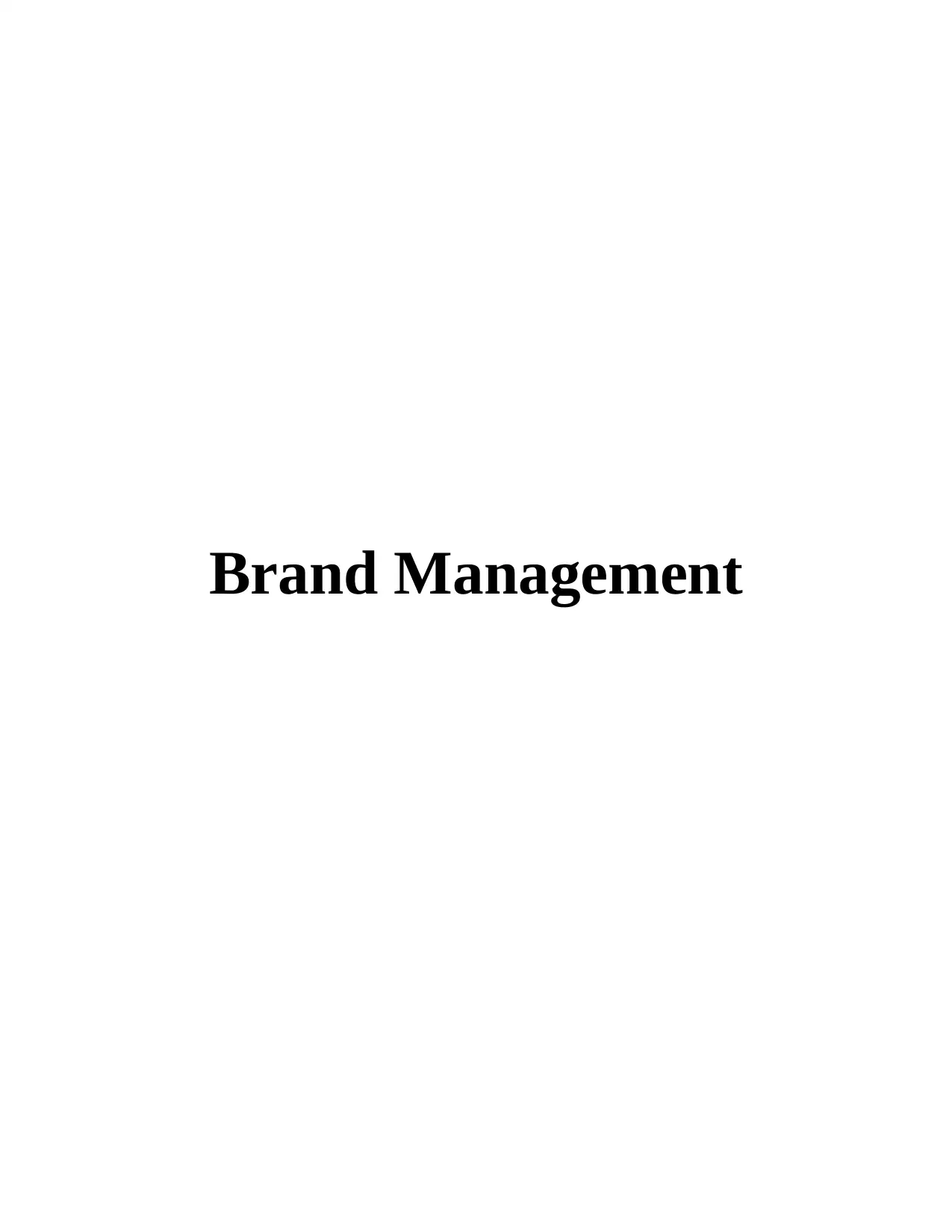
Brand Management
Paraphrase This Document
Need a fresh take? Get an instant paraphrase of this document with our AI Paraphraser
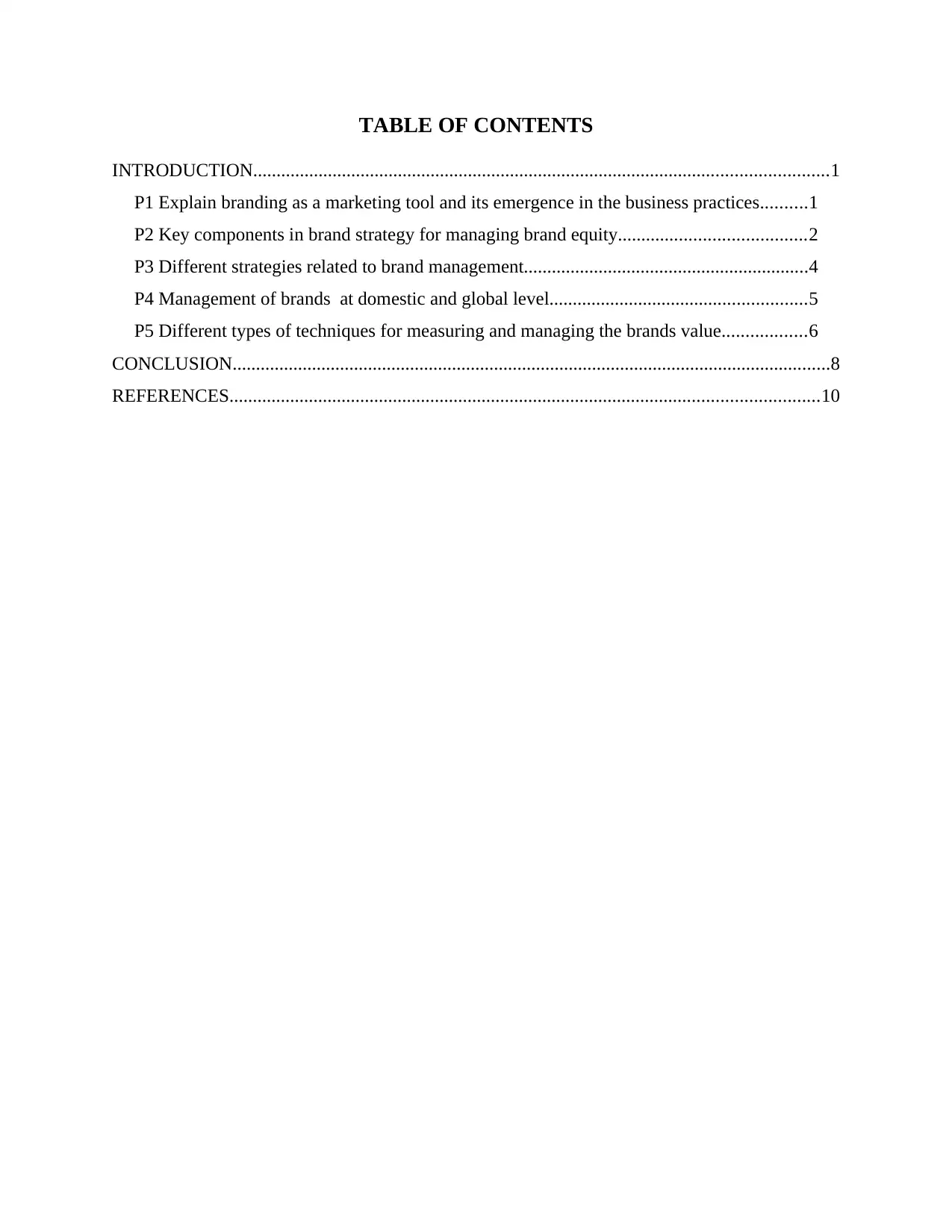
TABLE OF CONTENTS
INTRODUCTION...........................................................................................................................1
P1 Explain branding as a marketing tool and its emergence in the business practices..........1
P2 Key components in brand strategy for managing brand equity........................................2
P3 Different strategies related to brand management.............................................................4
P4 Management of brands at domestic and global level.......................................................5
P5 Different types of techniques for measuring and managing the brands value..................6
CONCLUSION................................................................................................................................8
REFERENCES..............................................................................................................................10
INTRODUCTION...........................................................................................................................1
P1 Explain branding as a marketing tool and its emergence in the business practices..........1
P2 Key components in brand strategy for managing brand equity........................................2
P3 Different strategies related to brand management.............................................................4
P4 Management of brands at domestic and global level.......................................................5
P5 Different types of techniques for measuring and managing the brands value..................6
CONCLUSION................................................................................................................................8
REFERENCES..............................................................................................................................10
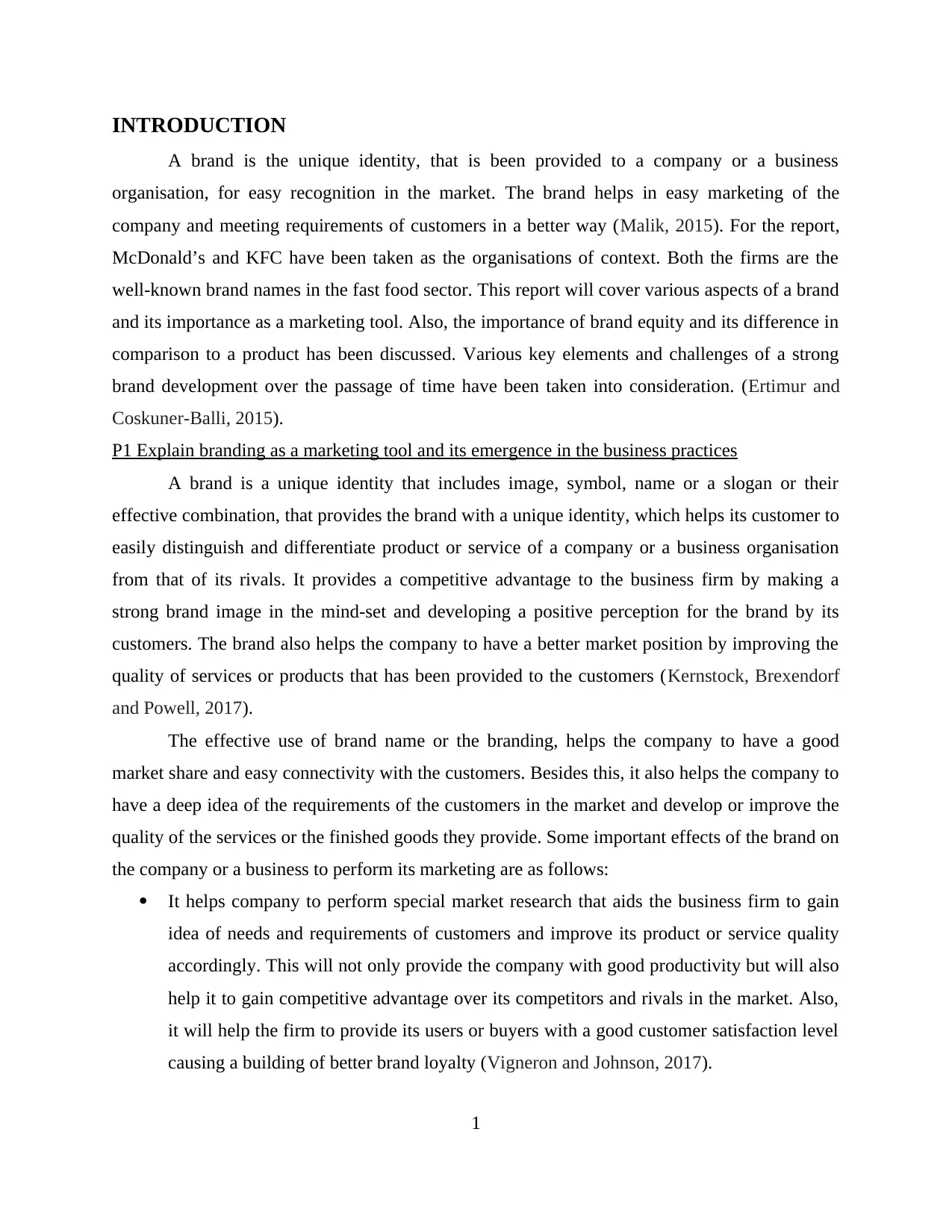
INTRODUCTION
A brand is the unique identity, that is been provided to a company or a business
organisation, for easy recognition in the market. The brand helps in easy marketing of the
company and meeting requirements of customers in a better way (Malik, 2015). For the report,
McDonald’s and KFC have been taken as the organisations of context. Both the firms are the
well-known brand names in the fast food sector. This report will cover various aspects of a brand
and its importance as a marketing tool. Also, the importance of brand equity and its difference in
comparison to a product has been discussed. Various key elements and challenges of a strong
brand development over the passage of time have been taken into consideration. (Ertimur and
Coskuner-Balli, 2015).
P1 Explain branding as a marketing tool and its emergence in the business practices
A brand is a unique identity that includes image, symbol, name or a slogan or their
effective combination, that provides the brand with a unique identity, which helps its customer to
easily distinguish and differentiate product or service of a company or a business organisation
from that of its rivals. It provides a competitive advantage to the business firm by making a
strong brand image in the mind-set and developing a positive perception for the brand by its
customers. The brand also helps the company to have a better market position by improving the
quality of services or products that has been provided to the customers (Kernstock, Brexendorf
and Powell, 2017).
The effective use of brand name or the branding, helps the company to have a good
market share and easy connectivity with the customers. Besides this, it also helps the company to
have a deep idea of the requirements of the customers in the market and develop or improve the
quality of the services or the finished goods they provide. Some important effects of the brand on
the company or a business to perform its marketing are as follows:
It helps company to perform special market research that aids the business firm to gain
idea of needs and requirements of customers and improve its product or service quality
accordingly. This will not only provide the company with good productivity but will also
help it to gain competitive advantage over its competitors and rivals in the market. Also,
it will help the firm to provide its users or buyers with a good customer satisfaction level
causing a building of better brand loyalty (Vigneron and Johnson, 2017).
1
A brand is the unique identity, that is been provided to a company or a business
organisation, for easy recognition in the market. The brand helps in easy marketing of the
company and meeting requirements of customers in a better way (Malik, 2015). For the report,
McDonald’s and KFC have been taken as the organisations of context. Both the firms are the
well-known brand names in the fast food sector. This report will cover various aspects of a brand
and its importance as a marketing tool. Also, the importance of brand equity and its difference in
comparison to a product has been discussed. Various key elements and challenges of a strong
brand development over the passage of time have been taken into consideration. (Ertimur and
Coskuner-Balli, 2015).
P1 Explain branding as a marketing tool and its emergence in the business practices
A brand is a unique identity that includes image, symbol, name or a slogan or their
effective combination, that provides the brand with a unique identity, which helps its customer to
easily distinguish and differentiate product or service of a company or a business organisation
from that of its rivals. It provides a competitive advantage to the business firm by making a
strong brand image in the mind-set and developing a positive perception for the brand by its
customers. The brand also helps the company to have a better market position by improving the
quality of services or products that has been provided to the customers (Kernstock, Brexendorf
and Powell, 2017).
The effective use of brand name or the branding, helps the company to have a good
market share and easy connectivity with the customers. Besides this, it also helps the company to
have a deep idea of the requirements of the customers in the market and develop or improve the
quality of the services or the finished goods they provide. Some important effects of the brand on
the company or a business to perform its marketing are as follows:
It helps company to perform special market research that aids the business firm to gain
idea of needs and requirements of customers and improve its product or service quality
accordingly. This will not only provide the company with good productivity but will also
help it to gain competitive advantage over its competitors and rivals in the market. Also,
it will help the firm to provide its users or buyers with a good customer satisfaction level
causing a building of better brand loyalty (Vigneron and Johnson, 2017).
1
⊘ This is a preview!⊘
Do you want full access?
Subscribe today to unlock all pages.

Trusted by 1+ million students worldwide
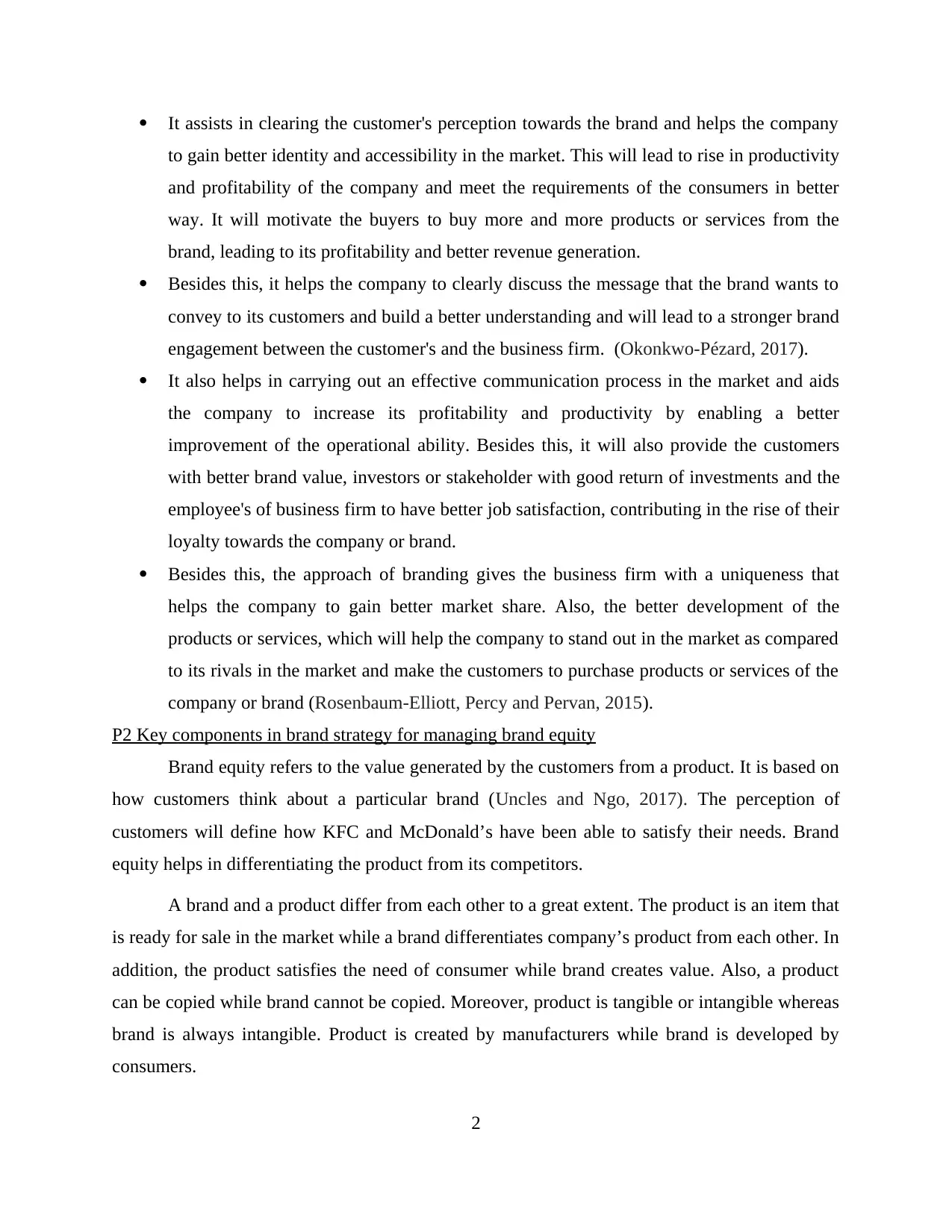
It assists in clearing the customer's perception towards the brand and helps the company
to gain better identity and accessibility in the market. This will lead to rise in productivity
and profitability of the company and meet the requirements of the consumers in better
way. It will motivate the buyers to buy more and more products or services from the
brand, leading to its profitability and better revenue generation.
Besides this, it helps the company to clearly discuss the message that the brand wants to
convey to its customers and build a better understanding and will lead to a stronger brand
engagement between the customer's and the business firm. (Okonkwo-Pézard, 2017).
It also helps in carrying out an effective communication process in the market and aids
the company to increase its profitability and productivity by enabling a better
improvement of the operational ability. Besides this, it will also provide the customers
with better brand value, investors or stakeholder with good return of investments and the
employee's of business firm to have better job satisfaction, contributing in the rise of their
loyalty towards the company or brand.
Besides this, the approach of branding gives the business firm with a uniqueness that
helps the company to gain better market share. Also, the better development of the
products or services, which will help the company to stand out in the market as compared
to its rivals in the market and make the customers to purchase products or services of the
company or brand (Rosenbaum-Elliott, Percy and Pervan, 2015).
P2 Key components in brand strategy for managing brand equity
Brand equity refers to the value generated by the customers from a product. It is based on
how customers think about a particular brand (Uncles and Ngo, 2017). The perception of
customers will define how KFC and McDonald’s have been able to satisfy their needs. Brand
equity helps in differentiating the product from its competitors.
A brand and a product differ from each other to a great extent. The product is an item that
is ready for sale in the market while a brand differentiates company’s product from each other. In
addition, the product satisfies the need of consumer while brand creates value. Also, a product
can be copied while brand cannot be copied. Moreover, product is tangible or intangible whereas
brand is always intangible. Product is created by manufacturers while brand is developed by
consumers.
2
to gain better identity and accessibility in the market. This will lead to rise in productivity
and profitability of the company and meet the requirements of the consumers in better
way. It will motivate the buyers to buy more and more products or services from the
brand, leading to its profitability and better revenue generation.
Besides this, it helps the company to clearly discuss the message that the brand wants to
convey to its customers and build a better understanding and will lead to a stronger brand
engagement between the customer's and the business firm. (Okonkwo-Pézard, 2017).
It also helps in carrying out an effective communication process in the market and aids
the company to increase its profitability and productivity by enabling a better
improvement of the operational ability. Besides this, it will also provide the customers
with better brand value, investors or stakeholder with good return of investments and the
employee's of business firm to have better job satisfaction, contributing in the rise of their
loyalty towards the company or brand.
Besides this, the approach of branding gives the business firm with a uniqueness that
helps the company to gain better market share. Also, the better development of the
products or services, which will help the company to stand out in the market as compared
to its rivals in the market and make the customers to purchase products or services of the
company or brand (Rosenbaum-Elliott, Percy and Pervan, 2015).
P2 Key components in brand strategy for managing brand equity
Brand equity refers to the value generated by the customers from a product. It is based on
how customers think about a particular brand (Uncles and Ngo, 2017). The perception of
customers will define how KFC and McDonald’s have been able to satisfy their needs. Brand
equity helps in differentiating the product from its competitors.
A brand and a product differ from each other to a great extent. The product is an item that
is ready for sale in the market while a brand differentiates company’s product from each other. In
addition, the product satisfies the need of consumer while brand creates value. Also, a product
can be copied while brand cannot be copied. Moreover, product is tangible or intangible whereas
brand is always intangible. Product is created by manufacturers while brand is developed by
consumers.
2
Paraphrase This Document
Need a fresh take? Get an instant paraphrase of this document with our AI Paraphraser
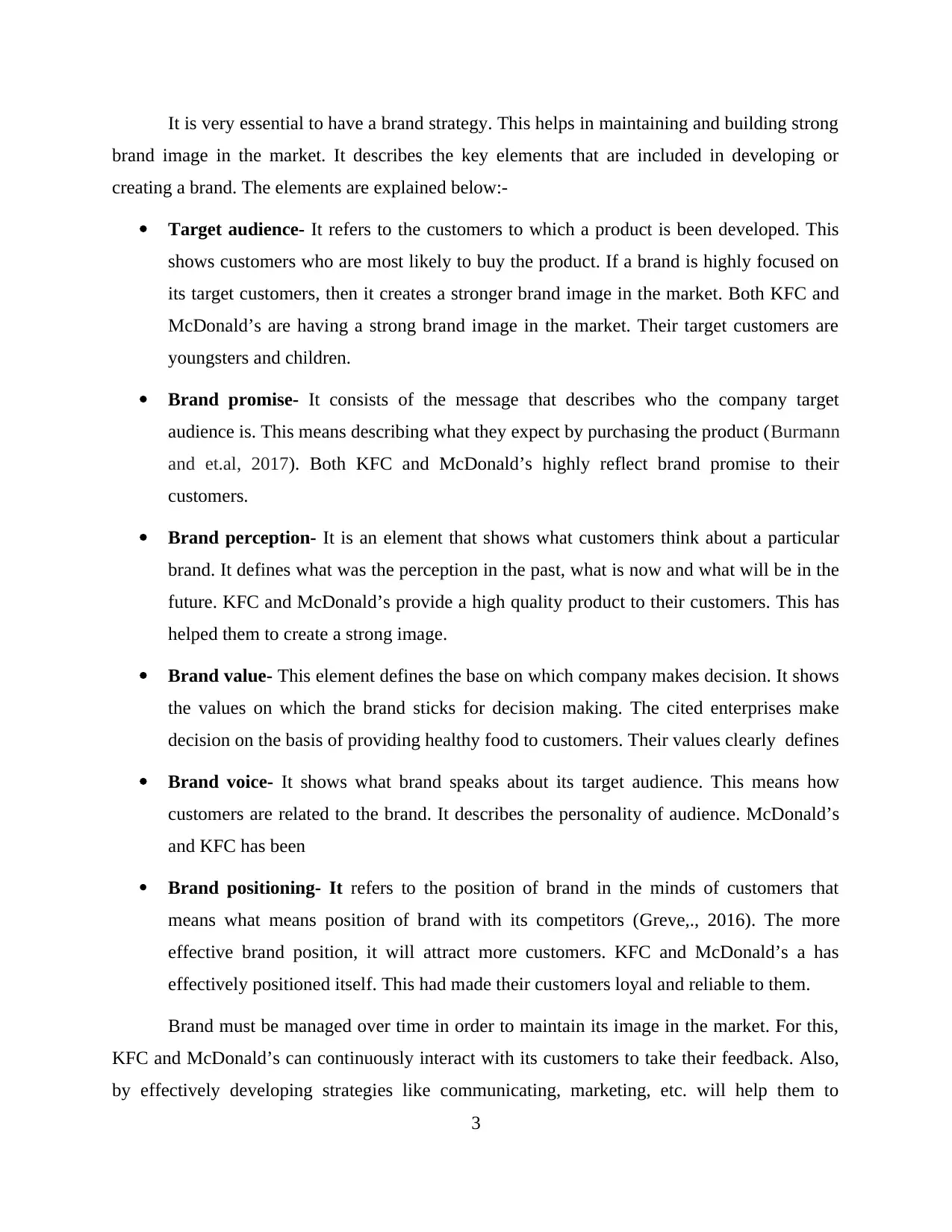
It is very essential to have a brand strategy. This helps in maintaining and building strong
brand image in the market. It describes the key elements that are included in developing or
creating a brand. The elements are explained below:-
Target audience- It refers to the customers to which a product is been developed. This
shows customers who are most likely to buy the product. If a brand is highly focused on
its target customers, then it creates a stronger brand image in the market. Both KFC and
McDonald’s are having a strong brand image in the market. Their target customers are
youngsters and children.
Brand promise- It consists of the message that describes who the company target
audience is. This means describing what they expect by purchasing the product (Burmann
and et.al, 2017). Both KFC and McDonald’s highly reflect brand promise to their
customers.
Brand perception- It is an element that shows what customers think about a particular
brand. It defines what was the perception in the past, what is now and what will be in the
future. KFC and McDonald’s provide a high quality product to their customers. This has
helped them to create a strong image.
Brand value- This element defines the base on which company makes decision. It shows
the values on which the brand sticks for decision making. The cited enterprises make
decision on the basis of providing healthy food to customers. Their values clearly defines
Brand voice- It shows what brand speaks about its target audience. This means how
customers are related to the brand. It describes the personality of audience. McDonald’s
and KFC has been
Brand positioning- It refers to the position of brand in the minds of customers that
means what means position of brand with its competitors (Greve,., 2016). The more
effective brand position, it will attract more customers. KFC and McDonald’s a has
effectively positioned itself. This had made their customers loyal and reliable to them.
Brand must be managed over time in order to maintain its image in the market. For this,
KFC and McDonald’s can continuously interact with its customers to take their feedback. Also,
by effectively developing strategies like communicating, marketing, etc. will help them to
3
brand image in the market. It describes the key elements that are included in developing or
creating a brand. The elements are explained below:-
Target audience- It refers to the customers to which a product is been developed. This
shows customers who are most likely to buy the product. If a brand is highly focused on
its target customers, then it creates a stronger brand image in the market. Both KFC and
McDonald’s are having a strong brand image in the market. Their target customers are
youngsters and children.
Brand promise- It consists of the message that describes who the company target
audience is. This means describing what they expect by purchasing the product (Burmann
and et.al, 2017). Both KFC and McDonald’s highly reflect brand promise to their
customers.
Brand perception- It is an element that shows what customers think about a particular
brand. It defines what was the perception in the past, what is now and what will be in the
future. KFC and McDonald’s provide a high quality product to their customers. This has
helped them to create a strong image.
Brand value- This element defines the base on which company makes decision. It shows
the values on which the brand sticks for decision making. The cited enterprises make
decision on the basis of providing healthy food to customers. Their values clearly defines
Brand voice- It shows what brand speaks about its target audience. This means how
customers are related to the brand. It describes the personality of audience. McDonald’s
and KFC has been
Brand positioning- It refers to the position of brand in the minds of customers that
means what means position of brand with its competitors (Greve,., 2016). The more
effective brand position, it will attract more customers. KFC and McDonald’s a has
effectively positioned itself. This had made their customers loyal and reliable to them.
Brand must be managed over time in order to maintain its image in the market. For this,
KFC and McDonald’s can continuously interact with its customers to take their feedback. Also,
by effectively developing strategies like communicating, marketing, etc. will help them to
3
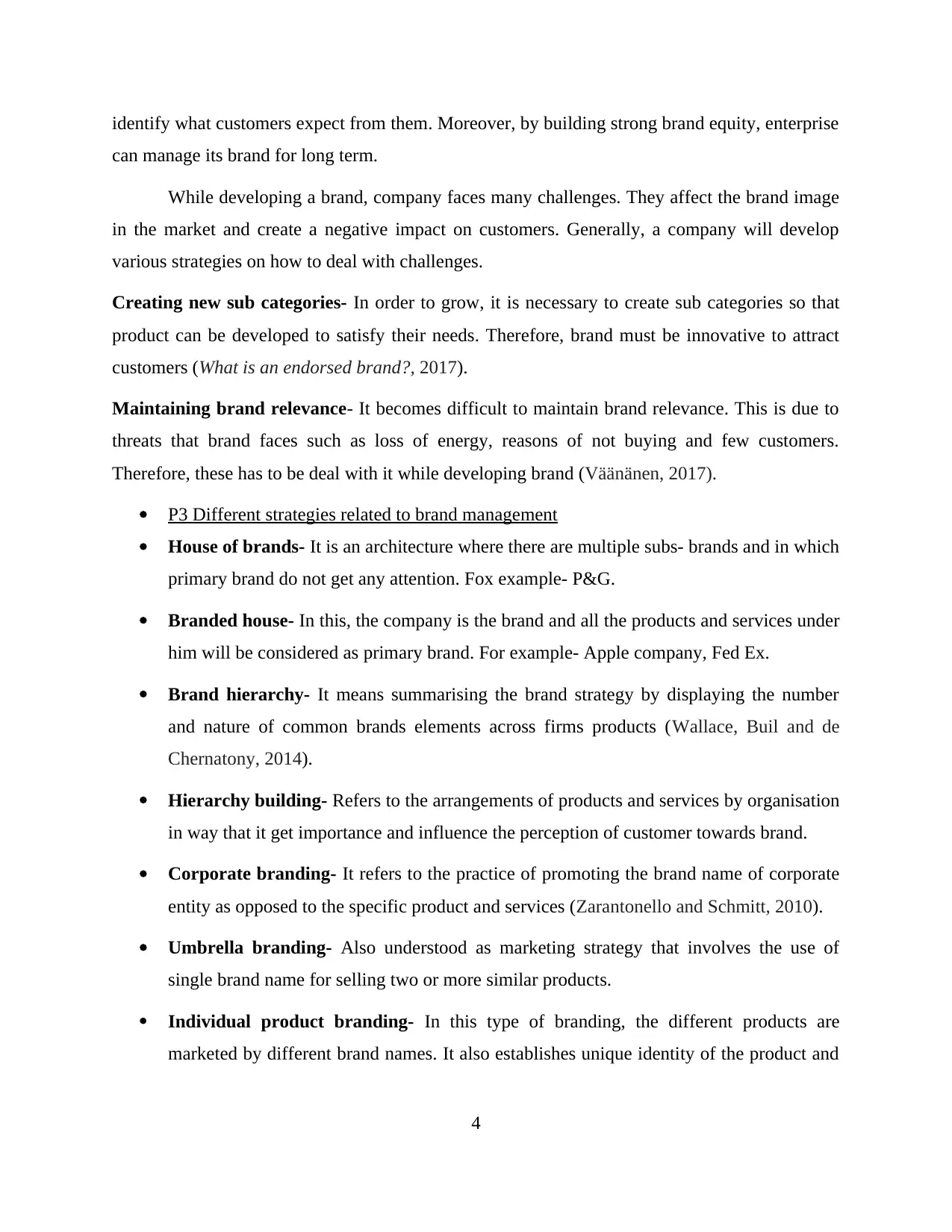
identify what customers expect from them. Moreover, by building strong brand equity, enterprise
can manage its brand for long term.
While developing a brand, company faces many challenges. They affect the brand image
in the market and create a negative impact on customers. Generally, a company will develop
various strategies on how to deal with challenges.
Creating new sub categories- In order to grow, it is necessary to create sub categories so that
product can be developed to satisfy their needs. Therefore, brand must be innovative to attract
customers (What is an endorsed brand?, 2017).
Maintaining brand relevance- It becomes difficult to maintain brand relevance. This is due to
threats that brand faces such as loss of energy, reasons of not buying and few customers.
Therefore, these has to be deal with it while developing brand (Väänänen, 2017).
P3 Different strategies related to brand management
House of brands- It is an architecture where there are multiple subs- brands and in which
primary brand do not get any attention. Fox example- P&G.
Branded house- In this, the company is the brand and all the products and services under
him will be considered as primary brand. For example- Apple company, Fed Ex.
Brand hierarchy- It means summarising the brand strategy by displaying the number
and nature of common brands elements across firms products (Wallace, Buil and de
Chernatony, 2014).
Hierarchy building- Refers to the arrangements of products and services by organisation
in way that it get importance and influence the perception of customer towards brand.
Corporate branding- It refers to the practice of promoting the brand name of corporate
entity as opposed to the specific product and services (Zarantonello and Schmitt, 2010).
Umbrella branding- Also understood as marketing strategy that involves the use of
single brand name for selling two or more similar products.
Individual product branding- In this type of branding, the different products are
marketed by different brand names. It also establishes unique identity of the product and
4
can manage its brand for long term.
While developing a brand, company faces many challenges. They affect the brand image
in the market and create a negative impact on customers. Generally, a company will develop
various strategies on how to deal with challenges.
Creating new sub categories- In order to grow, it is necessary to create sub categories so that
product can be developed to satisfy their needs. Therefore, brand must be innovative to attract
customers (What is an endorsed brand?, 2017).
Maintaining brand relevance- It becomes difficult to maintain brand relevance. This is due to
threats that brand faces such as loss of energy, reasons of not buying and few customers.
Therefore, these has to be deal with it while developing brand (Väänänen, 2017).
P3 Different strategies related to brand management
House of brands- It is an architecture where there are multiple subs- brands and in which
primary brand do not get any attention. Fox example- P&G.
Branded house- In this, the company is the brand and all the products and services under
him will be considered as primary brand. For example- Apple company, Fed Ex.
Brand hierarchy- It means summarising the brand strategy by displaying the number
and nature of common brands elements across firms products (Wallace, Buil and de
Chernatony, 2014).
Hierarchy building- Refers to the arrangements of products and services by organisation
in way that it get importance and influence the perception of customer towards brand.
Corporate branding- It refers to the practice of promoting the brand name of corporate
entity as opposed to the specific product and services (Zarantonello and Schmitt, 2010).
Umbrella branding- Also understood as marketing strategy that involves the use of
single brand name for selling two or more similar products.
Individual product branding- In this type of branding, the different products are
marketed by different brand names. It also establishes unique identity of the product and
4
⊘ This is a preview!⊘
Do you want full access?
Subscribe today to unlock all pages.

Trusted by 1+ million students worldwide
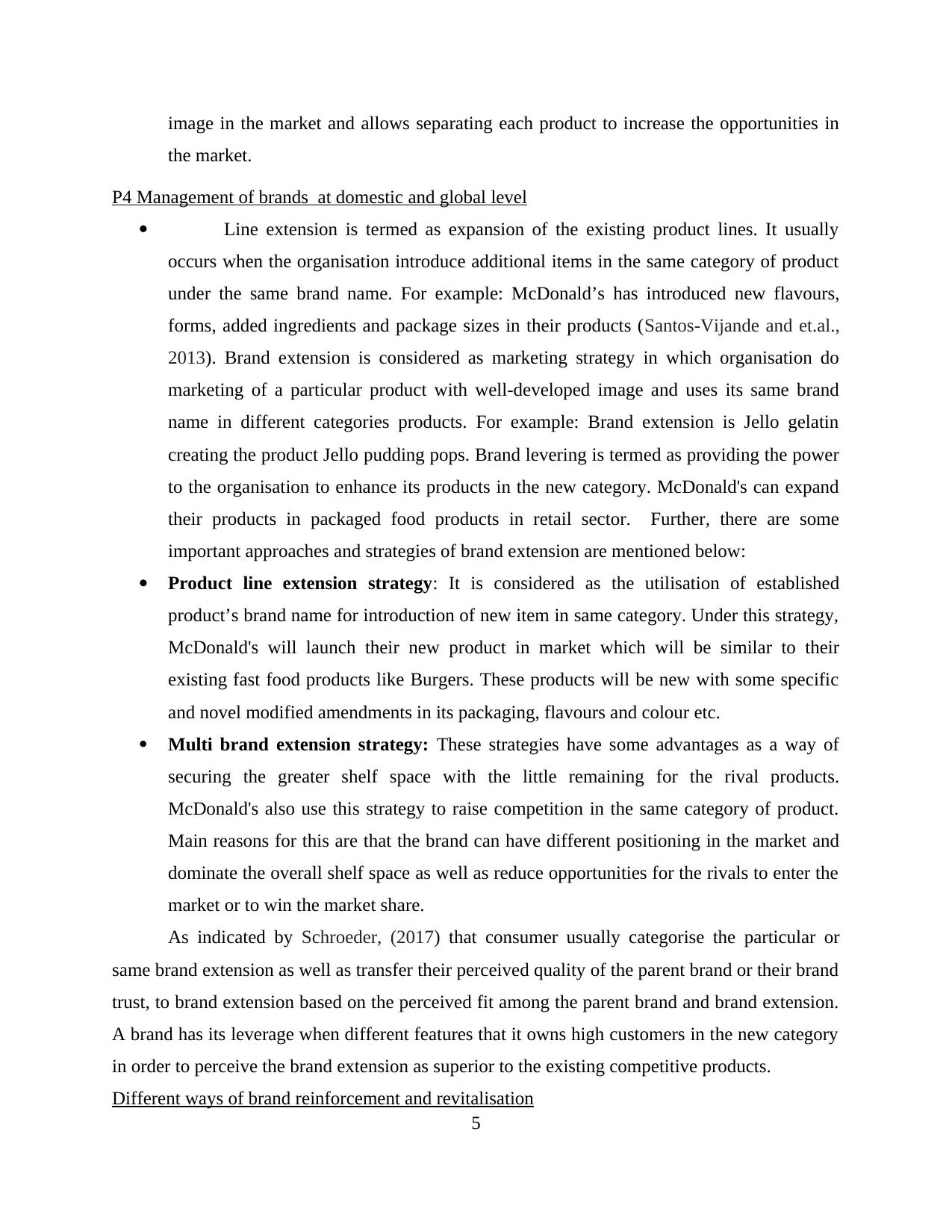
image in the market and allows separating each product to increase the opportunities in
the market.
P4 Management of brands at domestic and global level
Line extension is termed as expansion of the existing product lines. It usually
occurs when the organisation introduce additional items in the same category of product
under the same brand name. For example: McDonald’s has introduced new flavours,
forms, added ingredients and package sizes in their products (Santos-Vijande and et.al.,
2013). Brand extension is considered as marketing strategy in which organisation do
marketing of a particular product with well-developed image and uses its same brand
name in different categories products. For example: Brand extension is Jello gelatin
creating the product Jello pudding pops. Brand levering is termed as providing the power
to the organisation to enhance its products in the new category. McDonald's can expand
their products in packaged food products in retail sector. Further, there are some
important approaches and strategies of brand extension are mentioned below:
Product line extension strategy: It is considered as the utilisation of established
product’s brand name for introduction of new item in same category. Under this strategy,
McDonald's will launch their new product in market which will be similar to their
existing fast food products like Burgers. These products will be new with some specific
and novel modified amendments in its packaging, flavours and colour etc.
Multi brand extension strategy: These strategies have some advantages as a way of
securing the greater shelf space with the little remaining for the rival products.
McDonald's also use this strategy to raise competition in the same category of product.
Main reasons for this are that the brand can have different positioning in the market and
dominate the overall shelf space as well as reduce opportunities for the rivals to enter the
market or to win the market share.
As indicated by Schroeder, (2017) that consumer usually categorise the particular or
same brand extension as well as transfer their perceived quality of the parent brand or their brand
trust, to brand extension based on the perceived fit among the parent brand and brand extension.
A brand has its leverage when different features that it owns high customers in the new category
in order to perceive the brand extension as superior to the existing competitive products.
Different ways of brand reinforcement and revitalisation
5
the market.
P4 Management of brands at domestic and global level
Line extension is termed as expansion of the existing product lines. It usually
occurs when the organisation introduce additional items in the same category of product
under the same brand name. For example: McDonald’s has introduced new flavours,
forms, added ingredients and package sizes in their products (Santos-Vijande and et.al.,
2013). Brand extension is considered as marketing strategy in which organisation do
marketing of a particular product with well-developed image and uses its same brand
name in different categories products. For example: Brand extension is Jello gelatin
creating the product Jello pudding pops. Brand levering is termed as providing the power
to the organisation to enhance its products in the new category. McDonald's can expand
their products in packaged food products in retail sector. Further, there are some
important approaches and strategies of brand extension are mentioned below:
Product line extension strategy: It is considered as the utilisation of established
product’s brand name for introduction of new item in same category. Under this strategy,
McDonald's will launch their new product in market which will be similar to their
existing fast food products like Burgers. These products will be new with some specific
and novel modified amendments in its packaging, flavours and colour etc.
Multi brand extension strategy: These strategies have some advantages as a way of
securing the greater shelf space with the little remaining for the rival products.
McDonald's also use this strategy to raise competition in the same category of product.
Main reasons for this are that the brand can have different positioning in the market and
dominate the overall shelf space as well as reduce opportunities for the rivals to enter the
market or to win the market share.
As indicated by Schroeder, (2017) that consumer usually categorise the particular or
same brand extension as well as transfer their perceived quality of the parent brand or their brand
trust, to brand extension based on the perceived fit among the parent brand and brand extension.
A brand has its leverage when different features that it owns high customers in the new category
in order to perceive the brand extension as superior to the existing competitive products.
Different ways of brand reinforcement and revitalisation
5
Paraphrase This Document
Need a fresh take? Get an instant paraphrase of this document with our AI Paraphraser
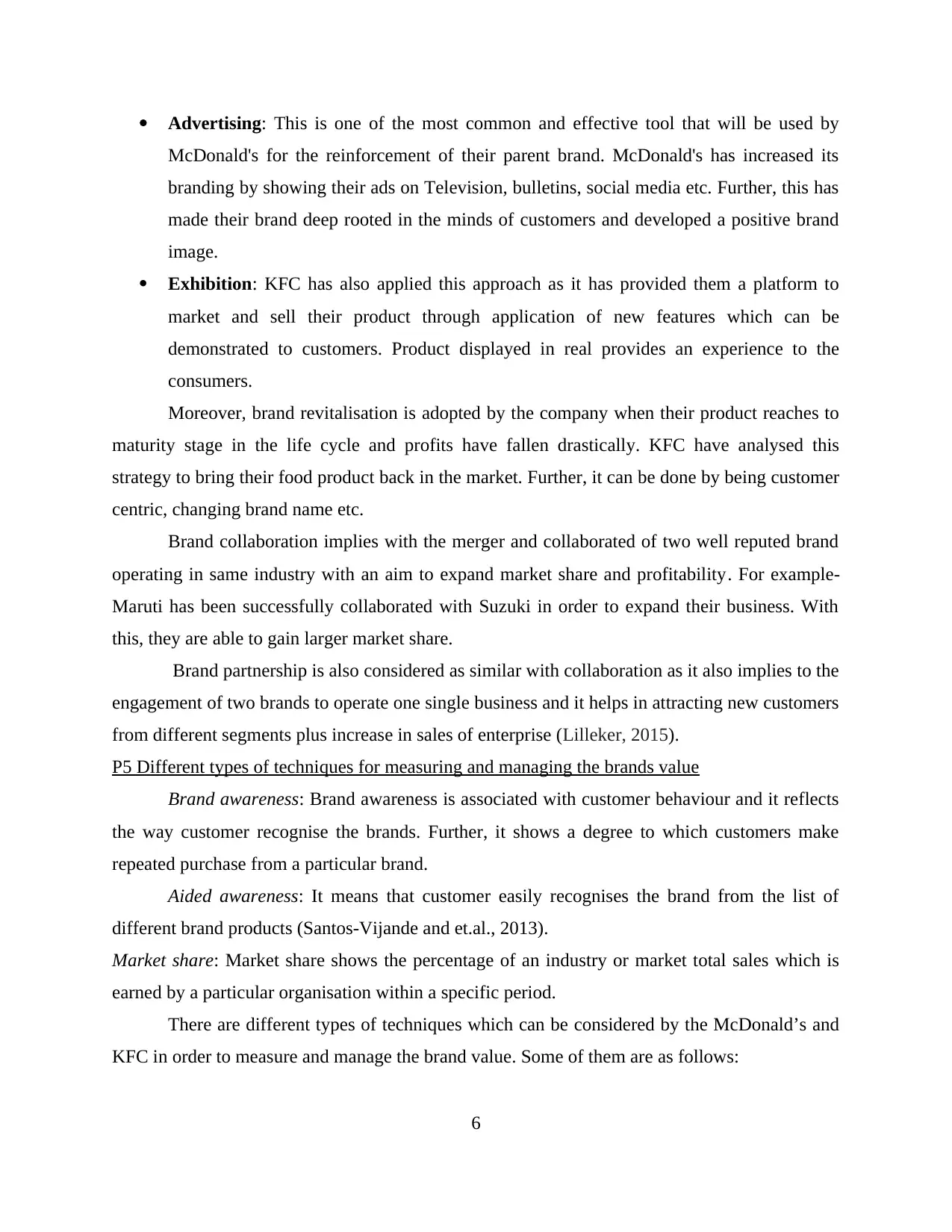
Advertising: This is one of the most common and effective tool that will be used by
McDonald's for the reinforcement of their parent brand. McDonald's has increased its
branding by showing their ads on Television, bulletins, social media etc. Further, this has
made their brand deep rooted in the minds of customers and developed a positive brand
image.
Exhibition: KFC has also applied this approach as it has provided them a platform to
market and sell their product through application of new features which can be
demonstrated to customers. Product displayed in real provides an experience to the
consumers.
Moreover, brand revitalisation is adopted by the company when their product reaches to
maturity stage in the life cycle and profits have fallen drastically. KFC have analysed this
strategy to bring their food product back in the market. Further, it can be done by being customer
centric, changing brand name etc.
Brand collaboration implies with the merger and collaborated of two well reputed brand
operating in same industry with an aim to expand market share and profitability. For example-
Maruti has been successfully collaborated with Suzuki in order to expand their business. With
this, they are able to gain larger market share.
Brand partnership is also considered as similar with collaboration as it also implies to the
engagement of two brands to operate one single business and it helps in attracting new customers
from different segments plus increase in sales of enterprise (Lilleker, 2015).
P5 Different types of techniques for measuring and managing the brands value
Brand awareness: Brand awareness is associated with customer behaviour and it reflects
the way customer recognise the brands. Further, it shows a degree to which customers make
repeated purchase from a particular brand.
Aided awareness: It means that customer easily recognises the brand from the list of
different brand products (Santos-Vijande and et.al., 2013).
Market share: Market share shows the percentage of an industry or market total sales which is
earned by a particular organisation within a specific period.
There are different types of techniques which can be considered by the McDonald’s and
KFC in order to measure and manage the brand value. Some of them are as follows:
6
McDonald's for the reinforcement of their parent brand. McDonald's has increased its
branding by showing their ads on Television, bulletins, social media etc. Further, this has
made their brand deep rooted in the minds of customers and developed a positive brand
image.
Exhibition: KFC has also applied this approach as it has provided them a platform to
market and sell their product through application of new features which can be
demonstrated to customers. Product displayed in real provides an experience to the
consumers.
Moreover, brand revitalisation is adopted by the company when their product reaches to
maturity stage in the life cycle and profits have fallen drastically. KFC have analysed this
strategy to bring their food product back in the market. Further, it can be done by being customer
centric, changing brand name etc.
Brand collaboration implies with the merger and collaborated of two well reputed brand
operating in same industry with an aim to expand market share and profitability. For example-
Maruti has been successfully collaborated with Suzuki in order to expand their business. With
this, they are able to gain larger market share.
Brand partnership is also considered as similar with collaboration as it also implies to the
engagement of two brands to operate one single business and it helps in attracting new customers
from different segments plus increase in sales of enterprise (Lilleker, 2015).
P5 Different types of techniques for measuring and managing the brands value
Brand awareness: Brand awareness is associated with customer behaviour and it reflects
the way customer recognise the brands. Further, it shows a degree to which customers make
repeated purchase from a particular brand.
Aided awareness: It means that customer easily recognises the brand from the list of
different brand products (Santos-Vijande and et.al., 2013).
Market share: Market share shows the percentage of an industry or market total sales which is
earned by a particular organisation within a specific period.
There are different types of techniques which can be considered by the McDonald’s and
KFC in order to measure and manage the brand value. Some of them are as follows:
6
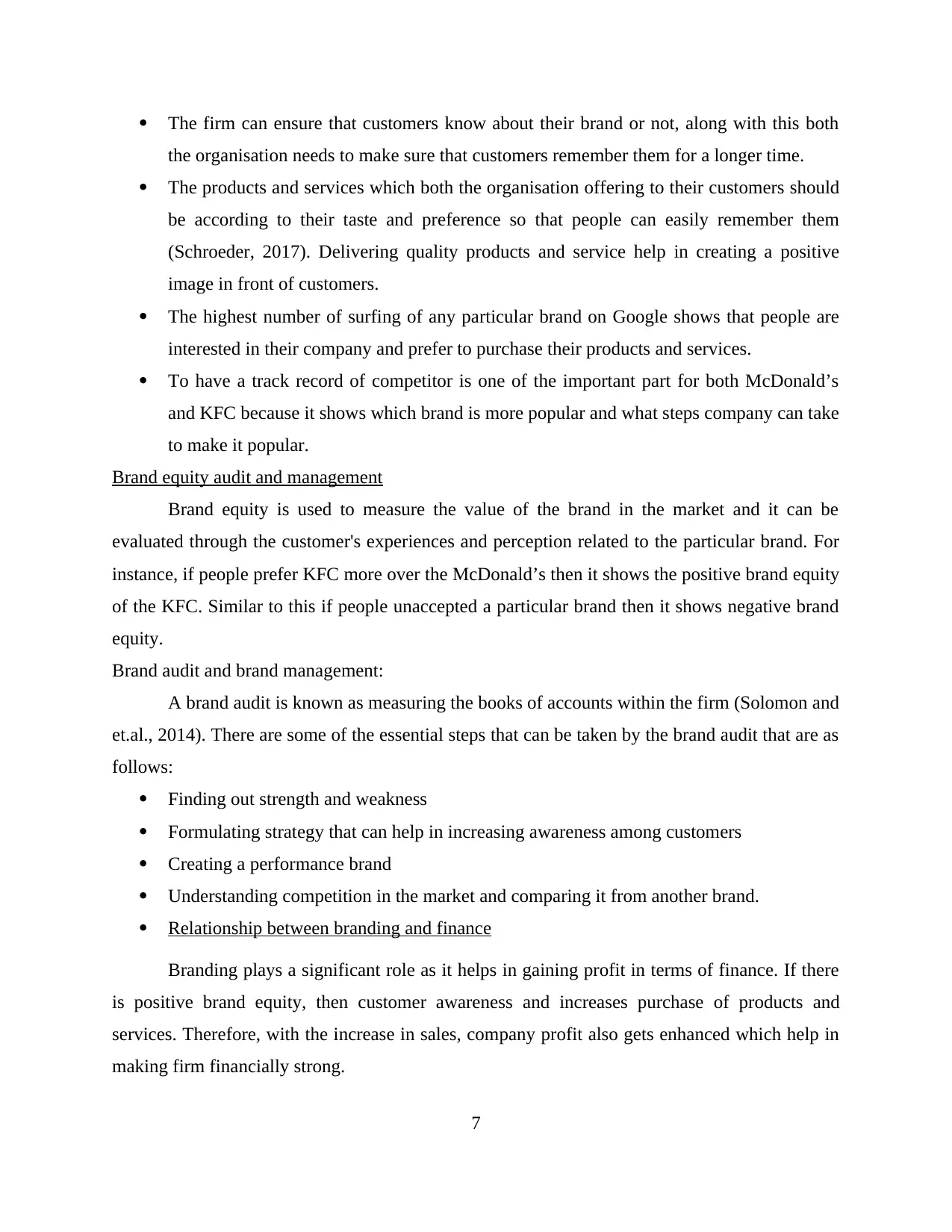
The firm can ensure that customers know about their brand or not, along with this both
the organisation needs to make sure that customers remember them for a longer time.
The products and services which both the organisation offering to their customers should
be according to their taste and preference so that people can easily remember them
(Schroeder, 2017). Delivering quality products and service help in creating a positive
image in front of customers.
The highest number of surfing of any particular brand on Google shows that people are
interested in their company and prefer to purchase their products and services.
To have a track record of competitor is one of the important part for both McDonald’s
and KFC because it shows which brand is more popular and what steps company can take
to make it popular.
Brand equity audit and management
Brand equity is used to measure the value of the brand in the market and it can be
evaluated through the customer's experiences and perception related to the particular brand. For
instance, if people prefer KFC more over the McDonald’s then it shows the positive brand equity
of the KFC. Similar to this if people unaccepted a particular brand then it shows negative brand
equity.
Brand audit and brand management:
A brand audit is known as measuring the books of accounts within the firm (Solomon and
et.al., 2014). There are some of the essential steps that can be taken by the brand audit that are as
follows:
Finding out strength and weakness
Formulating strategy that can help in increasing awareness among customers
Creating a performance brand
Understanding competition in the market and comparing it from another brand.
Relationship between branding and finance
Branding plays a significant role as it helps in gaining profit in terms of finance. If there
is positive brand equity, then customer awareness and increases purchase of products and
services. Therefore, with the increase in sales, company profit also gets enhanced which help in
making firm financially strong.
7
the organisation needs to make sure that customers remember them for a longer time.
The products and services which both the organisation offering to their customers should
be according to their taste and preference so that people can easily remember them
(Schroeder, 2017). Delivering quality products and service help in creating a positive
image in front of customers.
The highest number of surfing of any particular brand on Google shows that people are
interested in their company and prefer to purchase their products and services.
To have a track record of competitor is one of the important part for both McDonald’s
and KFC because it shows which brand is more popular and what steps company can take
to make it popular.
Brand equity audit and management
Brand equity is used to measure the value of the brand in the market and it can be
evaluated through the customer's experiences and perception related to the particular brand. For
instance, if people prefer KFC more over the McDonald’s then it shows the positive brand equity
of the KFC. Similar to this if people unaccepted a particular brand then it shows negative brand
equity.
Brand audit and brand management:
A brand audit is known as measuring the books of accounts within the firm (Solomon and
et.al., 2014). There are some of the essential steps that can be taken by the brand audit that are as
follows:
Finding out strength and weakness
Formulating strategy that can help in increasing awareness among customers
Creating a performance brand
Understanding competition in the market and comparing it from another brand.
Relationship between branding and finance
Branding plays a significant role as it helps in gaining profit in terms of finance. If there
is positive brand equity, then customer awareness and increases purchase of products and
services. Therefore, with the increase in sales, company profit also gets enhanced which help in
making firm financially strong.
7
⊘ This is a preview!⊘
Do you want full access?
Subscribe today to unlock all pages.

Trusted by 1+ million students worldwide
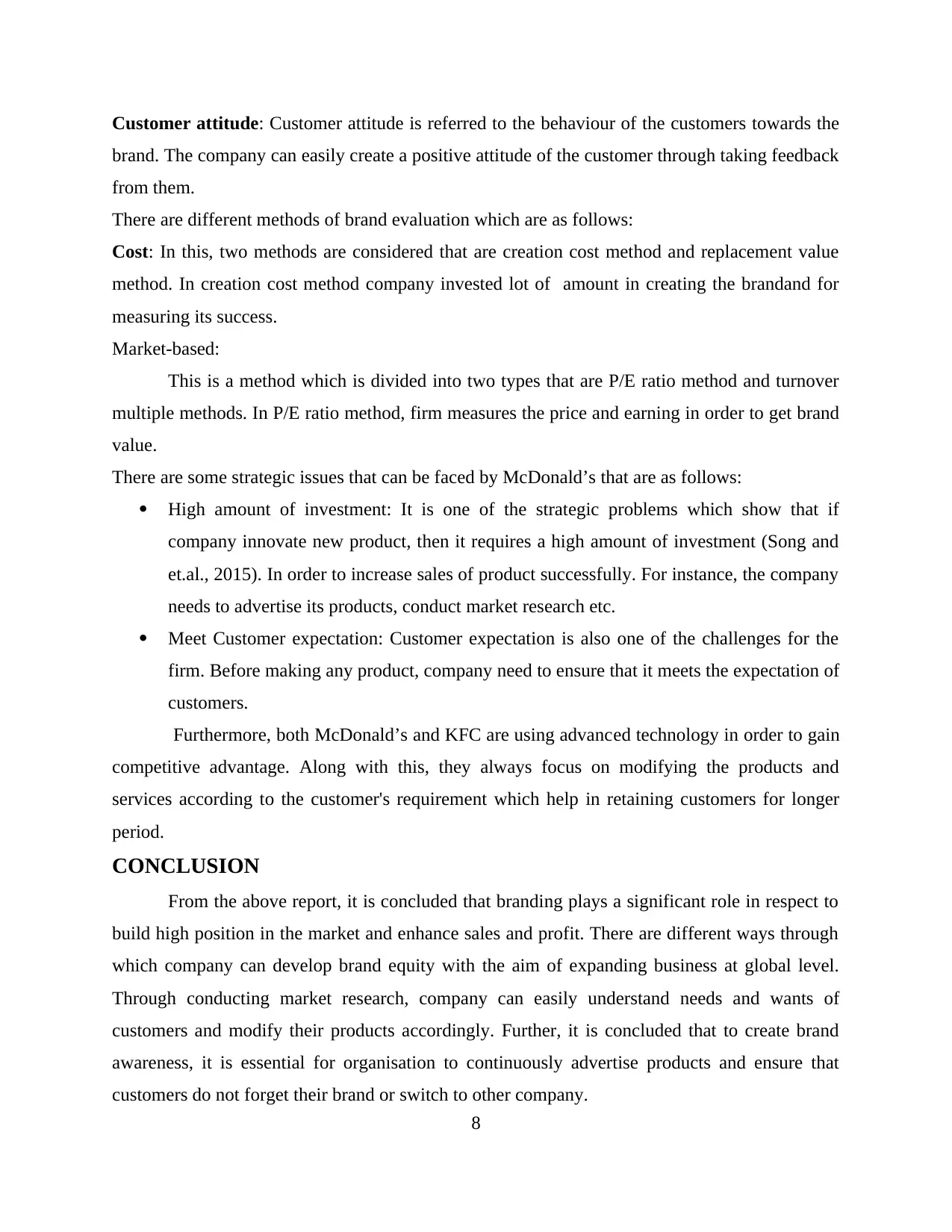
Customer attitude: Customer attitude is referred to the behaviour of the customers towards the
brand. The company can easily create a positive attitude of the customer through taking feedback
from them.
There are different methods of brand evaluation which are as follows:
Cost: In this, two methods are considered that are creation cost method and replacement value
method. In creation cost method company invested lot of amount in creating the brandand for
measuring its success.
Market-based:
This is a method which is divided into two types that are P/E ratio method and turnover
multiple methods. In P/E ratio method, firm measures the price and earning in order to get brand
value.
There are some strategic issues that can be faced by McDonald’s that are as follows:
High amount of investment: It is one of the strategic problems which show that if
company innovate new product, then it requires a high amount of investment (Song and
et.al., 2015). In order to increase sales of product successfully. For instance, the company
needs to advertise its products, conduct market research etc.
Meet Customer expectation: Customer expectation is also one of the challenges for the
firm. Before making any product, company need to ensure that it meets the expectation of
customers.
Furthermore, both McDonald’s and KFC are using advanced technology in order to gain
competitive advantage. Along with this, they always focus on modifying the products and
services according to the customer's requirement which help in retaining customers for longer
period.
CONCLUSION
From the above report, it is concluded that branding plays a significant role in respect to
build high position in the market and enhance sales and profit. There are different ways through
which company can develop brand equity with the aim of expanding business at global level.
Through conducting market research, company can easily understand needs and wants of
customers and modify their products accordingly. Further, it is concluded that to create brand
awareness, it is essential for organisation to continuously advertise products and ensure that
customers do not forget their brand or switch to other company.
8
brand. The company can easily create a positive attitude of the customer through taking feedback
from them.
There are different methods of brand evaluation which are as follows:
Cost: In this, two methods are considered that are creation cost method and replacement value
method. In creation cost method company invested lot of amount in creating the brandand for
measuring its success.
Market-based:
This is a method which is divided into two types that are P/E ratio method and turnover
multiple methods. In P/E ratio method, firm measures the price and earning in order to get brand
value.
There are some strategic issues that can be faced by McDonald’s that are as follows:
High amount of investment: It is one of the strategic problems which show that if
company innovate new product, then it requires a high amount of investment (Song and
et.al., 2015). In order to increase sales of product successfully. For instance, the company
needs to advertise its products, conduct market research etc.
Meet Customer expectation: Customer expectation is also one of the challenges for the
firm. Before making any product, company need to ensure that it meets the expectation of
customers.
Furthermore, both McDonald’s and KFC are using advanced technology in order to gain
competitive advantage. Along with this, they always focus on modifying the products and
services according to the customer's requirement which help in retaining customers for longer
period.
CONCLUSION
From the above report, it is concluded that branding plays a significant role in respect to
build high position in the market and enhance sales and profit. There are different ways through
which company can develop brand equity with the aim of expanding business at global level.
Through conducting market research, company can easily understand needs and wants of
customers and modify their products accordingly. Further, it is concluded that to create brand
awareness, it is essential for organisation to continuously advertise products and ensure that
customers do not forget their brand or switch to other company.
8
Paraphrase This Document
Need a fresh take? Get an instant paraphrase of this document with our AI Paraphraser

9
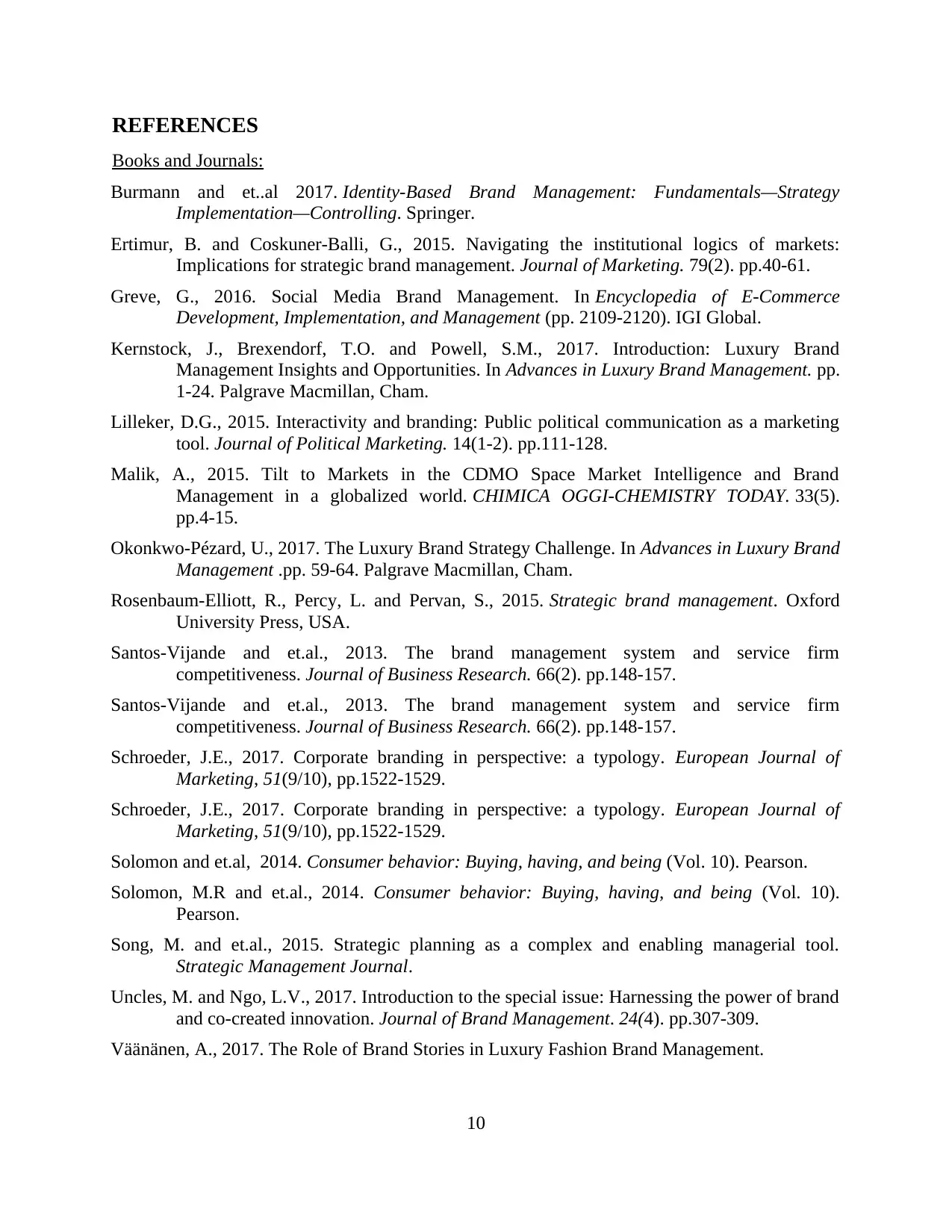
REFERENCES
Books and Journals:
Burmann and et..al 2017. Identity-Based Brand Management: Fundamentals—Strategy
Implementation—Controlling. Springer.
Ertimur, B. and Coskuner-Balli, G., 2015. Navigating the institutional logics of markets:
Implications for strategic brand management. Journal of Marketing. 79(2). pp.40-61.
Greve, G., 2016. Social Media Brand Management. In Encyclopedia of E-Commerce
Development, Implementation, and Management (pp. 2109-2120). IGI Global.
Kernstock, J., Brexendorf, T.O. and Powell, S.M., 2017. Introduction: Luxury Brand
Management Insights and Opportunities. In Advances in Luxury Brand Management. pp.
1-24. Palgrave Macmillan, Cham.
Lilleker, D.G., 2015. Interactivity and branding: Public political communication as a marketing
tool. Journal of Political Marketing. 14(1-2). pp.111-128.
Malik, A., 2015. Tilt to Markets in the CDMO Space Market Intelligence and Brand
Management in a globalized world. CHIMICA OGGI-CHEMISTRY TODAY. 33(5).
pp.4-15.
Okonkwo-Pézard, U., 2017. The Luxury Brand Strategy Challenge. In Advances in Luxury Brand
Management .pp. 59-64. Palgrave Macmillan, Cham.
Rosenbaum-Elliott, R., Percy, L. and Pervan, S., 2015. Strategic brand management. Oxford
University Press, USA.
Santos-Vijande and et.al., 2013. The brand management system and service firm
competitiveness. Journal of Business Research. 66(2). pp.148-157.
Santos-Vijande and et.al., 2013. The brand management system and service firm
competitiveness. Journal of Business Research. 66(2). pp.148-157.
Schroeder, J.E., 2017. Corporate branding in perspective: a typology. European Journal of
Marketing, 51(9/10), pp.1522-1529.
Schroeder, J.E., 2017. Corporate branding in perspective: a typology. European Journal of
Marketing, 51(9/10), pp.1522-1529.
Solomon and et.al, 2014. Consumer behavior: Buying, having, and being (Vol. 10). Pearson.
Solomon, M.R and et.al., 2014. Consumer behavior: Buying, having, and being (Vol. 10).
Pearson.
Song, M. and et.al., 2015. Strategic planning as a complex and enabling managerial tool.
Strategic Management Journal.
Uncles, M. and Ngo, L.V., 2017. Introduction to the special issue: Harnessing the power of brand
and co-created innovation. Journal of Brand Management. 24(4). pp.307-309.
Väänänen, A., 2017. The Role of Brand Stories in Luxury Fashion Brand Management.
10
Books and Journals:
Burmann and et..al 2017. Identity-Based Brand Management: Fundamentals—Strategy
Implementation—Controlling. Springer.
Ertimur, B. and Coskuner-Balli, G., 2015. Navigating the institutional logics of markets:
Implications for strategic brand management. Journal of Marketing. 79(2). pp.40-61.
Greve, G., 2016. Social Media Brand Management. In Encyclopedia of E-Commerce
Development, Implementation, and Management (pp. 2109-2120). IGI Global.
Kernstock, J., Brexendorf, T.O. and Powell, S.M., 2017. Introduction: Luxury Brand
Management Insights and Opportunities. In Advances in Luxury Brand Management. pp.
1-24. Palgrave Macmillan, Cham.
Lilleker, D.G., 2015. Interactivity and branding: Public political communication as a marketing
tool. Journal of Political Marketing. 14(1-2). pp.111-128.
Malik, A., 2015. Tilt to Markets in the CDMO Space Market Intelligence and Brand
Management in a globalized world. CHIMICA OGGI-CHEMISTRY TODAY. 33(5).
pp.4-15.
Okonkwo-Pézard, U., 2017. The Luxury Brand Strategy Challenge. In Advances in Luxury Brand
Management .pp. 59-64. Palgrave Macmillan, Cham.
Rosenbaum-Elliott, R., Percy, L. and Pervan, S., 2015. Strategic brand management. Oxford
University Press, USA.
Santos-Vijande and et.al., 2013. The brand management system and service firm
competitiveness. Journal of Business Research. 66(2). pp.148-157.
Santos-Vijande and et.al., 2013. The brand management system and service firm
competitiveness. Journal of Business Research. 66(2). pp.148-157.
Schroeder, J.E., 2017. Corporate branding in perspective: a typology. European Journal of
Marketing, 51(9/10), pp.1522-1529.
Schroeder, J.E., 2017. Corporate branding in perspective: a typology. European Journal of
Marketing, 51(9/10), pp.1522-1529.
Solomon and et.al, 2014. Consumer behavior: Buying, having, and being (Vol. 10). Pearson.
Solomon, M.R and et.al., 2014. Consumer behavior: Buying, having, and being (Vol. 10).
Pearson.
Song, M. and et.al., 2015. Strategic planning as a complex and enabling managerial tool.
Strategic Management Journal.
Uncles, M. and Ngo, L.V., 2017. Introduction to the special issue: Harnessing the power of brand
and co-created innovation. Journal of Brand Management. 24(4). pp.307-309.
Väänänen, A., 2017. The Role of Brand Stories in Luxury Fashion Brand Management.
10
⊘ This is a preview!⊘
Do you want full access?
Subscribe today to unlock all pages.

Trusted by 1+ million students worldwide
1 out of 13
Related Documents
Your All-in-One AI-Powered Toolkit for Academic Success.
+13062052269
info@desklib.com
Available 24*7 on WhatsApp / Email
![[object Object]](/_next/static/media/star-bottom.7253800d.svg)
Unlock your academic potential
Copyright © 2020–2025 A2Z Services. All Rights Reserved. Developed and managed by ZUCOL.





